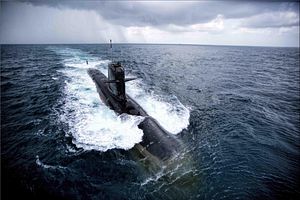The Indian Navy will commission the second Scorpene-class (Kalvari-class) diesel-electric attack submarine (SSK), the future INS Khanderi, on September 28 during a ceremony at a shipyard in Mumbai under the auspices of Indian Defense Minister Rajnath Singh.
With the Indian Ministry of Defense’s (MoD) Project-75 acquisition program running five years behind schedule, this month’s commissioning will mark a significant boost for the Indian Navy’s underwater combat capabilities.
Project-75 mandates the construction of six Kalvari-class SSKs for the Indian Navy by French state-owned submarine builder Naval Group, formerly known as Direction des Constructions Navales Services (DCNS), in cooperation with Indian shipbuilder Mazagon Dock Limited (MDL).
The commissioning date of the INS Khanderi has been repeatedly pushed back over the last two years. This June it was revealed that the Indian Navy refused to commission the submarine until a total of 36 defects and deficiencies had been addressed by Naval Group and MDL.
A senior Indian naval officer was quoted as saying that the service insisted on a “fully sea- and battle-worthy” and expressed particular concern over an “unacceptably high” engine and propeller noise level.
Addressing these, deficiencies would require testing the SSK on a calm sea. Given the ongoing Monsoon season in India, testing will likely only be able to occur in the later part of this month.
It is unclear whether the service is now caving in to MoD pressure, or whether all of the deficiencies will indeed be addressed by September 28.
The 1,565-ton conventionally powered submarine Khanderi was launched in January 2017 and began sea trials in July of the same year. Due to various technical and logistical problems, the commissioning date of the new SSK was time and again delayed over the last two years.
Earlier this year, I summarized the armament and technical characteristics of the Kalvari-class:
Powered by two 1250 kW MAN Diesel Engines, the SSK’s operational range is around 6,500 nautical miles (12,000 kilometers). Each SSK is powered by 360 battery cells and a permanently magnetized propulsion motor for operation under water.
While the class will not be equipped with an air-independent propulsion (AIP) system for the time being, there are plans to retrofit the boats with a domestically designed and built AIP in the coming years.
The Kalvari-class will be armed with French-made Exocet SM39 anti-ship missile, a sea-skimming, subsonic, solid-fueled anti-ship missile with an estimated operational range of 50-70 kilometers, and heavy-weight torpedoes. Each submarine can carry up to 18 anti-ship missiles or heavy-weight torpedoes.
For the time being, the future INS Khanderi, will likely be temporarily armed with an upgraded version of German-made AEG SUT 264 torpedoes as a stopgap measure until the induction of a new heavy weight torpedo for the Kalvari-class.
































